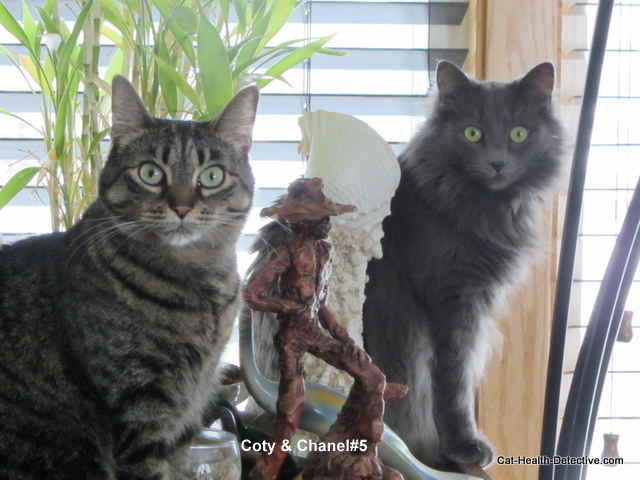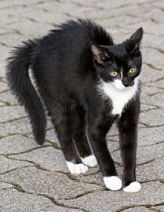Feline Bad Habits

Feline bad habits can be modified to fit in with what is acceptable to you and those in your household. However, first it’s a good idea to always have your cat checked out by your vet prior to addressing a behavior problem, to make sure there isn’t a medical reason for the unwanted behavior. If there is, you will need to treat the medical problem before you can expect to change behavior. Once your cat has a clean bill of health you can begin to deal with the behavior issues.
You have several options for modifying any unwanted behavior. All animals tend to repeat behaviors they find rewarding. Actions that aren’t rewarding in some way tend to diminish and then cease. To change behaviors we need to reward those behaviors that we do want, and make sure feline bad habits behaviors that we don’t want aren’t rewarded. This absolutely does not mean using physical punishment. This you can do:
- Manage the environment to prevent the behavior from happening, or to prevent her from being rewarded for the behavior.
- Redirect the behavior to more appropriate channels and find ways to make those more rewarding than the ones you don’t want.
- Accept the behavior by adjusting your own perception of and reaction to the problem.
One of the frequent complaints about feline bad habits is the sharpening of claws. This is a fairly easy one to remedy. First, be aware that cats are cats and they will claw. It’s what cats do. Stopping the behavior entirely isn’t an option, but only very rarely is a cat such an incorrigible scratcher that the behavior can’t be managed. You can :
- Manage the environment by removing any and all inviting but inappropriate scratch objects. Keep your cat in a scratch-proofed room when you are not around to intervene if she scratches inappropriately.
- Put stereo speakers that have material on the front, out of reach.
- Attach double-stick tape on surfaces that can’t be moved out her reach (or use a rug runner that has sharp plastic points on one side. Pointy side up, it deters cats from clawing).
- Try some of the commercial cat deterrent sprays and creams.
- Clip your cat’s nails or you can use Feline Soft Claws…colored plastic caps that are glued to the tips of the claws to prevent damage. This worked for me when we had a problem with Revlon scratching. These nails are small plastic sheaths that slip over the nail after you've added a drop of glue inside. It sticks almost instantly and they grow out normally as the nail grows. I only had to repeat the process once because the behavior had been modified and Revlon stopped scratching and now uses only the scratching post.
- Although use of a water-filled spray-mister may succeed in interrupting the scratching behavior, it’s preferable to avoid a punishment solution which will not get rid of feline bad habits. Plus, when you’re not there (she’s smart enough to know that you control the water-mister) the feline bad habits behavior continues in your absence.
- Some go the “declawing route” and I adamantly am against such a cruel procedure. Please read my article on this called Declawing Cats
- Redirect this feline bad habits issue to appropriate scratching
posts. This is critical to a successful scratch-management plan, and
may require some experimentation. Some cats like vertical scratching
posts (3 of mine do) and others prefer horizontal or posts set at an
angle (my other 3 do). Some like sisal rope posts, others favor
carpeting, cardboard, or just plain wood. Two of my cats are crazy for
the corrugated cardboard that came out a few years ago and you can get
refills when they’ve shredded it. If your cat is reluctant to use a
post at first, sprinkle a little catnip on it, crumble her favorite
kitty treat on it, or suspend a toy above the post to encourage
scratching.
Another of the feline bad habits is jumping on counters and furniture. We admire our cats for their athletic agility…the very quality that makes it so easy for them to gracefully fly through the air, leaping onto tall counters and tables, with a single bound. For our cats, the only time this really presents a problem is when we have company over. Coty and Max Factor can’t understand why it’s okay for them to be on the table every day except when people are visiting…and we shouldn't expect them to understand.
Although most of our friends are cat lovers and don’t get offended with a cat’s face trying to see what they are eating, a few gentle removals are usually enough to convince our two curious cats to leave the dinner table.
Managing counter surfing means never leaving food on the counter if you are not there to guard it. It only takes one close encounter with a slice of roast beef for a cat’s brain to be imprinted with the inalienable conviction that the counter is a wonderful place to be. Coty will fish a shrimp out of a sink of cool water (that is thawing the shrimp) and run off with it. For a cat who already loves the counter or table top, you may need to make the surface inhospitable when you’re not around to intervene, by covering it with aluminum foil, or a cloth or platter covered with double-stick tape.
If you can’t do that, confine your cat in another room so she doesn't have access to the forbidden spots during your absence. In our case, Coty and Chanel are counter cats and I don’t mind them being on the counter when there is no food preparation going on. I am careful never to leave food on the counter and they have learned the command…”get down!” and obey promptly. This is a personal preference and what is acceptable to me but may not be acceptable to another cat owner.
You can also redirect the feline bad habits of counter surfing or table sitting. Cats love to sit up high, and they love sunspots. Find a place like a sunny windowsill (or several) to install a carpeted cat shelf and you may find your cat spending her time there instead of on the middle of the dining room table, especially if you open the window so she can smell the fresh air and hear birds chattering.
You can reinforce this spot by rewarding her with her favorite kitty treats whenever you see her there. If a sunspot is attracting her to the counter or table, close the shades or drapes to block the sun to those places. In our case, we accept the feline bad habits behavior as long as Coty and Chanel keep it under control. A little cat hair wont’ hurt us…especially when we have 6 cats!
Feline bad habits include litter box mishaps. A lot of cats can point to litter box problems as the reason they’ve been sent to a shelter and this is sad because the majority of the litter box issues are owner-caused problems. There are lots of inexpensive, reasonable solutions. Manage the environment. This is the most effective solution for litter box failure. A dirty litter box is the single most common reason that poop ends up on the floor instead of the litter. The definition of “dirty” varies from one cat to the next. Max Factor and Revlon, our two cats that are the least concerned with litter box cleanliness, would use a box of wall-to-wall urine and feces before either would dream of doing anything on the floor.
Chanel and Coty are more fastidious but will try to find me and whine. I then know something is amiss and check their food bowls and litter box. They still will use the box if they must, but will take forever finding a clean section. This is an absolute rarity because I frequently scoop the litter boxes during the day. I usually make my rounds dealing with the three litter boxes in the morning, late afternoon prior to dinner and again before going to bed at night.
If I happen to walk by one of the litter boxes and it looks
like someone has been “busy”, I will also scoop it then to help keep
feline bad habits at bay. Weekly or at least every two weeks empty all
of the litter and clean the box thoroughly. Refill it with new litter
and you’re done until next time.
Another common reason for feline bad habits regarding a litter box failure is that
there is something wrong with the box itself. Perhaps it’s too small
and their butt hangs over the edge…that’s easy…get a bigger box.
Covered boxes, while better to look at for us, are often offensive to
the feline sensibilities. The hood holds the odor in the box (which is
why humans like them), and given that your cat’s sense of smell is
infinitely superior to our own…this smell may be intolerable to the cat.
She might also dislike the feeling of bumping into the hood and walls
as she turns in the box. She may feel trapped in the hood, especially
if another cat tends to bully her while she’s occupied in the box. Some
cats love the privacy of a covered box while others hate the
confinement. Fancy litter boxes are more for your sake than for your
cat's.
Or, you may simply have a location problem. This is especially true with a new cat in a large or active household. The box may be too far away to be convenient or the cat may need more privacy than you have provided. Try several boxes in several different locations until you can discern which she is most likely to use. Of course, the problem could be as simple as a substrate preference. Some prefer clay, others pellets…some don’t like the perfume of some clumping litters. Experiment!
Set out a group of litter boxes in one place, each containing a different kind of litter. You can even try sand and potting soil, in addition to commercial litters. For one week, clean the boxes at least twice a day. You should get a clear picture of which litter your cat prefers. You may have friends that use different litters that will donate some to your cause but if you have to purchase them, donate the excess unused litter of the non-preferred brands your cat won’t use…to your local animal shelter.
There are some things you can to do about feline bad habits that will help redirect behavior while you are solving the litter box dilemma. Be sure to use an enzyme-based cleaner such as Nature’s Miracle to clean any soiled spots on floors or carpets so your cat isn’t attracted back to that spot by the odor. This is covered in greater detail in the article titled Cat Urine Remover
You can also set a plant or table over the spot or, if feasible, try placing her food and water there. Most cats won’t want to soil their eating area. It may also help to keep the cat in a small room, such as a bathroom, until she is routinely using her regularly cleaned box with her favorite litter in it, and then gradually give her more freedom until you know she is reliably using the box.
If you should happen to interrupt your cat in the act of doing her business in an unacceptable spot, interrupt her behavior, but do not throw her into her litter box or use punishment of any kind in or around her box. The more negative associations she has with her box area (including holding her paws to make her scratch in the litter), the less likely she s to use it.
Incidentally, some cats like our cat Revlon, do not cover their
feces. If you cat doesn’t cover them don’t bother to try to change
them. The main thing is that the box is being used. I find it amusing
that L’Oreal Blaze (Revlon’s sister) will come along later and cover it
for her.
Feline bad habits and the acceptance of them may not seem like an option but it’s not as absurd as it sounds. I accept that if I don’t clean out our cats’ boxes frequently, one of them may occasionally leave a deposit on the tile next to the box. Tile is easy to clean and I can live with that. I recognize that it’s my fault not theirs if I don’t do my part. I feel especially blessed that we have few litter box problems with the six cats in our household.
Eating plants is another of the feline bad habits. This is potentially dangerous behavior as well as an annoying one. Cats love to chew on plants. At best, your plants look tattered and you occasionally clean up piles of green cat vomit. At worst, your cat can ingest a poisonous houseplant and become extremely ill, or die. If you cat is a grazer you must manage this behavior by immediately removing any dangerous plants from your home.
For those that remain, you can hang them out of her reach or try spraying them with a commercial or homemade deterrent spray. Test the spray on a leaf first and wait a week or so, to be sure the plant won’t shrivel up and die. Or, again, confine the cat to a safe space when you are not there to intervene.
With Coty and L’Oreal Blaze, the two plant eaters in our home, we get a small tub of greens for them to munch on. Or of course, you can plant your own seeds to grow herbs and other greens, but first check with your vet to make sure the greens you are growing are safe for cats to eat.
However, you still may be cleaning up small piles of green cat vomit. If you don’t mid tattered plants and green piles and you are sure the houseplants you have are not dangerous, you can let your cats munch to their heart’s content. Another option is to get plants that have their own defenses like cacti.
There are other feline bad habits that you can run into, especially when you have taken in shelter cats or strays as we have. A complete list would be too lengthy. Remember to always check with your vet first to make sure the feline bad habits aren’t medically related. Then get creative and figure out how to manage the environment to prevent the behavior…or accept the behavior and adapt to it by keeping it under control.
Most unwanted feline bad habits can be modified. If you aren't successful, you might want to find a cat behavior consultant (animal behaviorist) in your area to help you. In dealing with feline bad habits, your patience will be rewarded with the lovable purring of your little critters.
Related Articles......
Return from Feline Bad Habits to Cat Health Homepage
Having trouble finding what you need? Cat Health Index & Site Map
OR
Do you have a question to ask?...Questions
OR
Do you have a cat story to share?...Simply click here to go to that page!
Copyright@2010-2020 All rights reserved.Cat-health-detective.com
This website is information only. Consult a veterinarian for medical assistance

"Like Us" on Facebook
or...
"Like Us" here




















